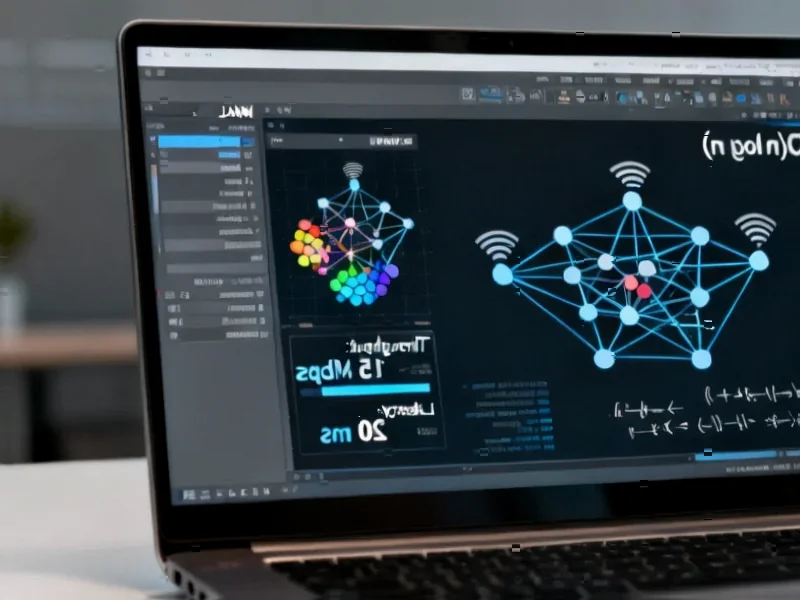According to Nature, researchers have developed an artificial intelligence model that can accurately predict heat transfer in double-inclined air jet systems used for industrial cooling. The experimental study used a 9.5 mm jet diameter and tested parameters including jet inclination angles from 0° to 60°, spacing between jets from 2D to 8D, Reynolds numbers from 10,000 to 40,000, and nozzle-to-plate distances from 2D to 8D. The artificial neural network model featured 16 hidden layers with 24 neurons each, using the ADAM optimizer and achieving exceptional accuracy with R² values approximately 1 and minimal error metrics including MSE of 6.265 and MAPE of 0.796%. The study found optimal performance at inclination angles between 10° and 20° and jet spacing of 3D to 4D. This research represents a significant step toward AI-driven thermal management solutions.
Table of Contents
Transforming Thermal Management Design
The ability to predict heat transfer performance with such accuracy using AI models represents a paradigm shift for industries relying on precision cooling. Traditional thermal management design has always involved extensive prototyping and testing cycles, particularly for applications like gas turbine blade cooling where even minor improvements in efficiency translate to substantial operational benefits. What makes this approach revolutionary is that engineers can now simulate thousands of design variations computationally before ever building physical prototypes. The 0.796% mean absolute percentage error achieved in this study means manufacturers could confidently optimize cooling systems for specific spatial constraints and thermal loads without the traditional trial-and-error approach that consumes both time and resources.
The Neural Network Architecture Advantage
The choice of 16 hidden layers with 24 neurons each represents a sophisticated approach to capturing the complex, non-linear relationships in jet impingement heat transfer. Unlike traditional computational fluid dynamics that solve complex differential equations, this ANN architecture learns the underlying patterns directly from experimental data. The use of ReLU activation functions in hidden layers combined with linear activation in the output layer is particularly well-suited for regression problems like predicting the Nusselt number. What’s often overlooked in such studies is the computational efficiency gained – once trained, these models can provide instant predictions, whereas traditional CFD simulations might take hours or days for similar analyses. This speed advantage makes iterative design optimization practically feasible for engineering teams working under tight deadlines.
Implementation Hurdles and Data Requirements
While the results are impressive, several practical challenges remain before widespread industrial adoption. The model’s accuracy depends heavily on the quality and scope of the training data – the experimental dataset used here covered specific parameter ranges that may not encompass all real-world scenarios. Companies would need to validate these models against their own specific nozzle configurations and operating conditions. There’s also the black box problem common to neural networks – engineers may be hesitant to trust predictions without understanding the underlying physics. The research doesn’t address how these models would handle extreme operating conditions or how they scale to larger, more complex jet array configurations commonly used in industrial applications.
Beyond Traditional Cooling Systems
The implications extend far beyond the gas turbine and electronics cooling applications mentioned in the research. This AI-driven approach could revolutionize thermal management in emerging technologies like electric vehicle battery cooling, data center server optimization, and even renewable energy systems. The ability to optimize inclination angles and spacing for maximum heat transfer could lead to more compact and efficient thermal solutions across multiple industries. As computational power increases and more experimental data becomes available, we’re likely to see similar AI models developed for conjugate heat transfer problems involving phase change, mixed convection, and other complex thermal phenomena that currently challenge traditional analysis methods.
Accelerating Innovation Cycles
The most significant impact may be on innovation speed rather than just performance optimization. Thermal management has traditionally been a bottleneck in product development cycles, particularly for electronics where cooling constraints often dictate form factors and performance limits. With accurate predictive models, engineers can explore radical new cooling architectures that would be too risky or time-consuming to test physically. This could lead to breakthrough designs in everything from high-performance computing to aerospace systems. The combination of experimental validation and AI prediction creates a virtuous cycle where each new dataset improves model accuracy, enabling even more ambitious thermal management solutions in subsequent design iterations.



